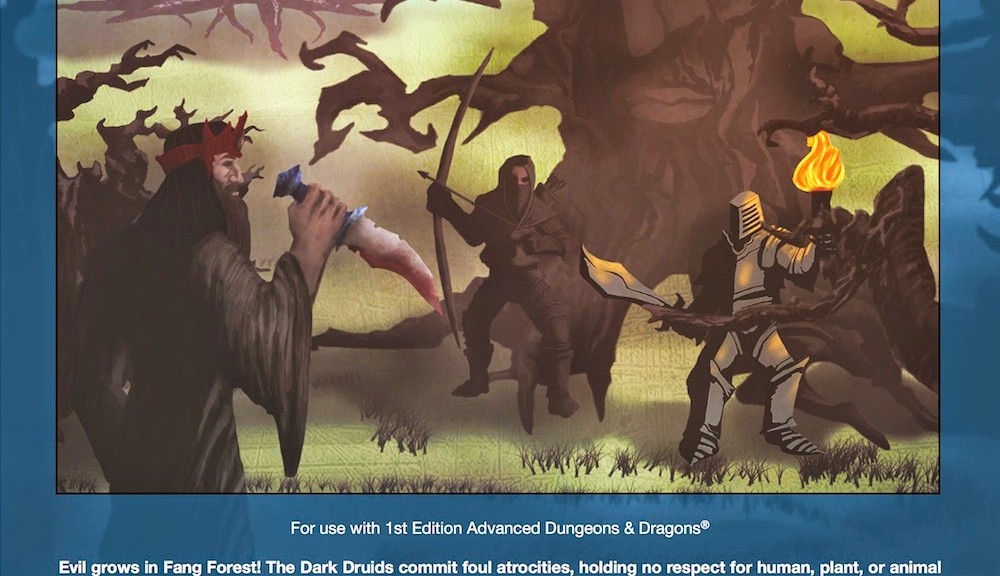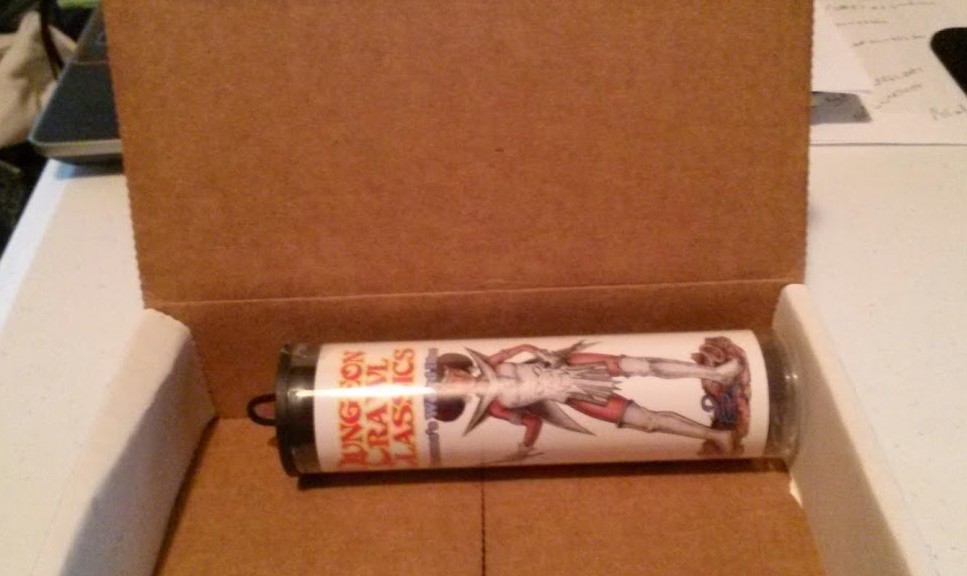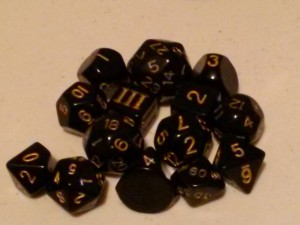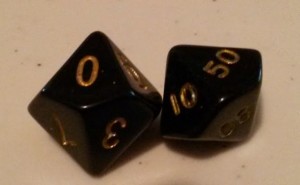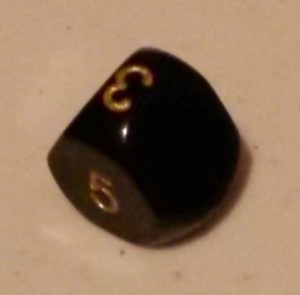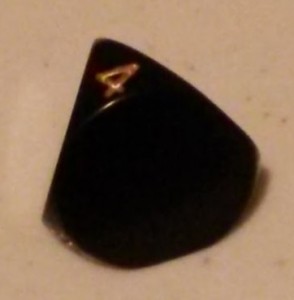The Manor is an RPG Fan Zine published by +Tim Shorts of Gothridge Manor.
I had not purchased The Manor before. I have heard good things about it and several of the other RPG Zines, I just try to focus on things I know I will use. When I read that there was a streamlined grappling system for use with Swords & Wizardry, I bought it. I was curious because grappling in AD&D is “clunky”. In AD&D, it feels like it is a “blow by blow” combat, as opposed to how melee and missile combat is abstracted. I can deal with the blow by blow if it is simple.
Before I dig into the grappling article, I will mention the other contents. This issue of the manor is 26 pages, including the front and back cover. It has a few full page illustrations and some smaller illustrations throughout. It is not focused on one genre or rules system. Much of what it contains can easily be used in any system. Four artists did illustrations for the cover and seven internal pages. I don’t know all the artists in the OSR, but the cover is awesome and the internal art is of varying “quality”. While not all of the internal art exhibits the same level of skill, I feel that all of it is better than much of the early art I have seen in the original LBB’s. It is definitely better than I could do, so it is not a complaint! One cool thing about the OSR is that it brings together authors, artists, cartographers, and others and whether out of the love of it, or for a few dollars, it exposes more of us to the work of others. A zine is a fan produced magazine, so its quality is a factor of the skill, tools, and resources the producer has to put into it. I believe the quality is top notch.
As expected, there is an introduction to this issue by Tim that touches on the delays in its production and a glimpse into each article and author.
+Trey Causey of From The Sorcerer’s Skull, has an article with a player humanoid clade, for his SF Setting Supplement Strange Stars – on sale now as part of the Science Fiction Sale as part of Star Wars Day. Trey has a page about his Strange Stars supplement so you can learn more about it before you buy it.
Tim wrote the last two articles, Hirelings – 6 pages with a table on the number of general hirelings avaialble by settlement size, and the cost of specific hirelings, a table of hireling skills/knacks, and six named hirelings, with one full page illustration. These are some helpful tables, and give ideas that can be expanded.
The second article by Tim is Torchbearer, a continuation of the previous article. In its 3-1/2 pages, including a full page illustration. Tim presents 8 different kinds of torches and 5 torchbearer skills to flesh out a torchbearer to be more than just cannon fodder. From Tim’s experience as a DM in one on one play, he finds that players often need NPC’s to help them accomplish their objectives.
The grappling article, by +Douglas Cole, of Gaming Ballistic and +Peter V. Dell’Orto, is 9 pages including the initial full page illustration, that is a repeat of the cover, and a 3/4 page illustration for the last page and a half page illustration in the middle of the article.
They clearly state that their goal is to present something that is easily applicable to player characters, NPC’s, and monsters. Something simple, that can be done without referring to tables.
Attacks are a normal d20 roll to hit. Instead of HP as are used in regular combat and subdual, they use Control Points (CP), which is immediately regained if breaking free from a grapple.
They have suggested options to tweak the system, and have two methods of tracking grappling. One is a bookkeeping mechanic of tracking the aforementioned Control Points (CP). The other is a chart with an increasing degree of effects of the grapple and if it is improved or minimized.
I think this system is what we have been needing for a simple mechanic for grappling, that makes grappling an option players would choose. Various options and outcomes that are realistic in grappling are discussed and addressed. While not perfect, I can’t think of how else to handle it without building yet another new subsystem just for grappling. This is simple enough that it can easily be implemented at your next session. I know that I will use it, if I need to resolve a grappling issue.
I bought this issue of The Manor just for the grappling article. If you have never tried to run grappling in AD&D you won’t get it. I have no idea how grappling works in other versions, or other rules, but they must all be clunky for someone who likes GURPS to come up with a simplified system.*
Like the blog articles, and PDFs available for free, or the PDFs, modules, manuals, books, and other zines available for a fee, the OSR shares how others do it, or ideas they had that others might find useful. Not every idea is a neat fit for everyone. With the OSR you are presented a buffet of ideas from which to choose. If you find someone else’s idea is not to your taste, you can move on to look at the next idea in your personal line of the way you interact with the OSR. None of us have all the same bookmarks, blog lists, or G+ Communities, so we don’t all have the same list of options from which to choose, or at least not in the same order. We learn of options we didn’t find in our own search, in the shared finds of others. We are free to choose those things that fit our taste for our own use, enjoy them for their own sake, or ignore them.
Lastly, if you think you can do better making a zine than someone else, show me. Zines are not easy to produce. Sure word processors make it easier, but if you get separate software for layout, like the free Scribus, you still have to figure it out and get the layout right. You then have to produce it in physical form, if you offer that option. Not to forget the need for artists, mapmakers, and others to write articles, and perhaps an editor. I tried my hand at putting together a “zine” for April 1st, and it wasn’t that easy, even for just a crude cover and a couple of interior pages. Few people have all the skills to produce a complete issue of a zine that would make the whole thing of uniform high quality. That is, art, articles, formatting, and marketing.
Zines may not be for everyone. I only tend to buy individual issues of fee-based zines if I know they have something in them that I might find useful. Others seem to collect zines because they can, while others have no interest in zines.
My recommendation for any zine is look for articles that scratch an itch you have as a DM/GM. If the blurb advertising it does not indicate that it contains anything you might need for use at your own table, then don’t buy it. For this issue of The Manor, I zeroed in on one thing I knew I could use, if it was as simple as advertised. It contains other articles that I could use, some I may never use, and some I know I won’t use. I will point out that this was also true of The Dragon, and other early magazines from the early days. Not every issue had something that you could use at the table.
* [This last sentence comes off as a slam against GURPS. That was not my intent. Re-reading this sentence, it is not conveying what I meant, and at this point the simplest thing is to note my error. I have never played GURPS and only flipped through the rule books 25+ years ago in a store. I have no idea how grappling works in GURPS. I was trying to say something along the lines that they authors like GURPS. My assumption is that because grappling in clunky in AD&D 1st edition that it must be so in all editions and all other systems. Not having experience with grappling in any other edition or other systems, that is a dangerous assumption. There might be a mechanic in Top Secret, Boot Hill, Gamma World, etc., but I don’t ever remember grappling in those games (That was 30+ years ago.). Since I mostly play AD&D 1st edition, this is where I will use that system, and to which I should have limited my comments.]


